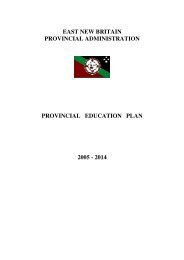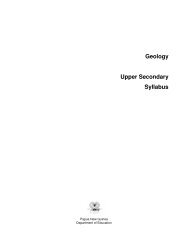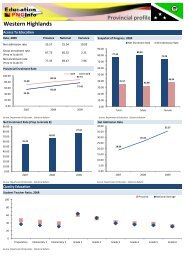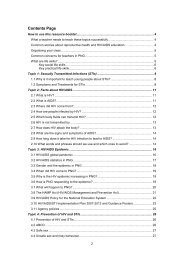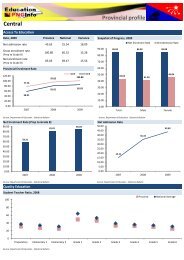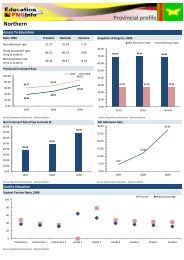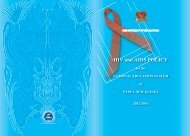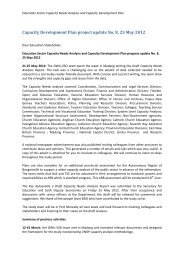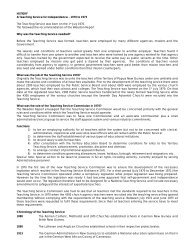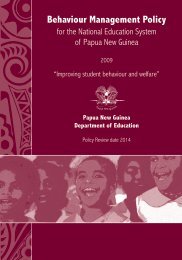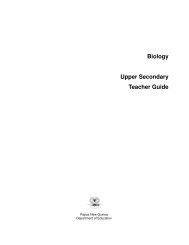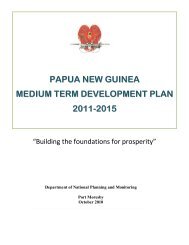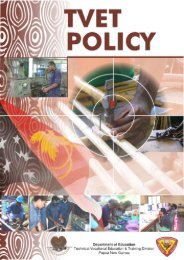Physical Education - Department of Education
Physical Education - Department of Education
Physical Education - Department of Education
You also want an ePaper? Increase the reach of your titles
YUMPU automatically turns print PDFs into web optimized ePapers that Google loves.
<strong>Physical</strong> education<br />
Teaching and learning approaches<br />
Teaching approach<br />
Learning outcomes that<br />
relate to the approach<br />
How to apply it<br />
Samples<br />
Discussion<br />
3.3.2 Describe the effects on<br />
the body when participating<br />
in physical activities<br />
5.3.3 Describe and perform a<br />
range <strong>of</strong> leisure and<br />
recreation activities<br />
Discussion <strong>of</strong>fers<br />
opportunities for:<br />
• assessing students’ level <strong>of</strong><br />
performance<br />
•the exchange <strong>of</strong> information<br />
between teachers and<br />
students, and students and<br />
students<br />
•students to gain<br />
understanding <strong>of</strong> and<br />
respect for each other’s<br />
feelings and the level <strong>of</strong><br />
performance<br />
•students to ask questions.<br />
•brainstorming<br />
•debates<br />
•question boxes<br />
•reporting<br />
•forums<br />
•interviews<br />
Practice and<br />
rehearsal<br />
3.2.1 Demonstrate different<br />
ways <strong>of</strong> moving to show<br />
body control and<br />
coordination<br />
4.2.1 Perform movement<br />
patterns and sequences<br />
that illustrate spatial<br />
awareness, coordination<br />
and flow<br />
Practice and rehearsal<br />
strategies require students to<br />
be placed in simulated<br />
situations that allow them to<br />
trial and refine skills and<br />
behaviours. Practice and<br />
rehearsal strategies should<br />
be:<br />
•relevant to real life<br />
situations<br />
•<strong>of</strong> sufficient duration to<br />
allow skill consolidation.<br />
•drills<br />
•skill checklists<br />
•simulations e.g. first aid/<br />
emergency situations<br />
•circuit activities<br />
•skills demonstrations<br />
Questioning<br />
3.1.1 Identify and<br />
demonstrate behaviour that<br />
promotes safety and avoids<br />
risks in physical activity<br />
5.3.1 Apply skills, rules and<br />
game plans to a range <strong>of</strong><br />
games and modified sports<br />
Questioning involves students<br />
in responding to and asking<br />
questions. Students’ response<br />
to questions may take<br />
different forms such as<br />
movement, written, verbal and<br />
pictorial responses.<br />
Questioning allows students<br />
to:<br />
•recall information<br />
• seek explanations<br />
•draw conclusions<br />
•think creatively.<br />
•quizzes and tests<br />
•question and answer<br />
situations<br />
•question box<br />
•interviews<br />
•case studies<br />
Demonstration<br />
3.3.1 Demonstrate simple<br />
ball-handling skills in games<br />
and modified sports using<br />
suitable equipment<br />
5.3.2 Participate daily in<br />
physical activities to<br />
improve movement skills<br />
and fitness<br />
Demonstrations can be used<br />
to:<br />
• illustrate variety or depth <strong>of</strong><br />
a skill or acceptable styles<br />
• show something unique or<br />
different<br />
• point out examples <strong>of</strong><br />
technique or approach<br />
• show progress.<br />
•teacher demonstration<br />
•demonstration by<br />
individual students<br />
•group demonstration<br />
•expert demonstration<br />
•audiovisual<br />
demonstration<br />
•construction <strong>of</strong> models<br />
9



